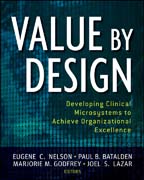
Value by design: developing clinical microsystems to achieve organizational excellence
Nelson, Eugene C.
Batalden, Paul B.
Godfrey, Marjorie M.
INDICE: Figures and Tables. Foreword (Elliott Fisher). Preface: Improvementat the Front Line of Care. Acknowledgments. The Editors. The Contributors. 1:Introducing Clinical Microsystems. Learning Objectives. Microsystems in Health Care. A Broader View of Systems and Microsystems. Research on Microsystems in Health Care. Three Conceptual Imperatives in the Work of Value Improvement. Conclusion. Summary. Key Terms. Review Questions. Discussion Questions. References. Set the following H1 in second color. Chapter One Action Guide. Introduction to the 5Ps. The Clinical Microsystem Process and Structure of the 5Ps Model. External Mapping Tool. Microsystem Assessment Tool (MAT). 2: Partnering with Patients to Design and Improve Care. Learning Objectives. The Aim of HealthCare and the Need to Partner with Patients. Conceptual Frameworks for Partnering with Patients. Tactics for Partnering with Patients. Patients as informants and Advisors. Conclusion. Summary. Key Terms. Review Questions. Discussion Questions. References. Set the following H1 in second color. Chapter Two ActionGuide. Institute for Family-Centered Care Matrix. Value Stream Mapping. Definitions of Selected Value Stream Mapping Terms. 3: Improving Safety and Anticipating Hazards in Clinical Microsystems. Learning Objectives. Organizational Factors to Promote A Culture of Safety (WHO). Discussion. Definitions. Identification of Medical Errors and Adverse Events. Frequency of Adverse Events and Medical Errors. Conclusion. Summary. Key Terms. Review Questions. Discussion Topics. References. Set the following H1 in second color. Chapter Three Action Guide. 5s Method. Checklists. Failure Mode and Effects Analysis. Rehearsals or Simulations. Mindfulness. The Link Between Safety and the Microsystem. Conclusion. References. 4: Using Measurement to Improve Health Care Value. Learning Objectives. Measuring What Matters at All Levels of the System. Tips and Principles to Foster a Rich information Environment. Designing information Flow to Support High-Value Care. Conclusion. Summary. Key Terms. Review Questions. Discussion Questions. References. Set the following H1 in second color. Chapter Four Action Guide. Patient Value Compass. Balanced Scorecard. Measure What Matters Worksheet. Examples of Data Walls. 5: Starting the Patient's Care in Clinical Microsystems. Learning Objectives. The Entry Functions of Clinical Microsystems. Conclusion. Summary. Key Terms. Review Questions. Discussion Questions. References. Set the following H1 in second color. Chapter Five Action Guide. Process Mapping with Flowcharts. Access Measures and Tools. C.A.R.E. Vital Signs. Reference. 6: Designing Preventive Care to Improve Health. Learning Objectives. The Work of Preventive Health Care. An Action-Based Taxonomy of PreventiveHeal
- ISBN: 978-0-470-38534-0
- Editorial: John Wiley & Sons
- Encuadernacion: Rústica
- Páginas: 340
- Fecha Publicación: 04/02/2011
- Nº Volúmenes: 1
- Idioma: Inglés
